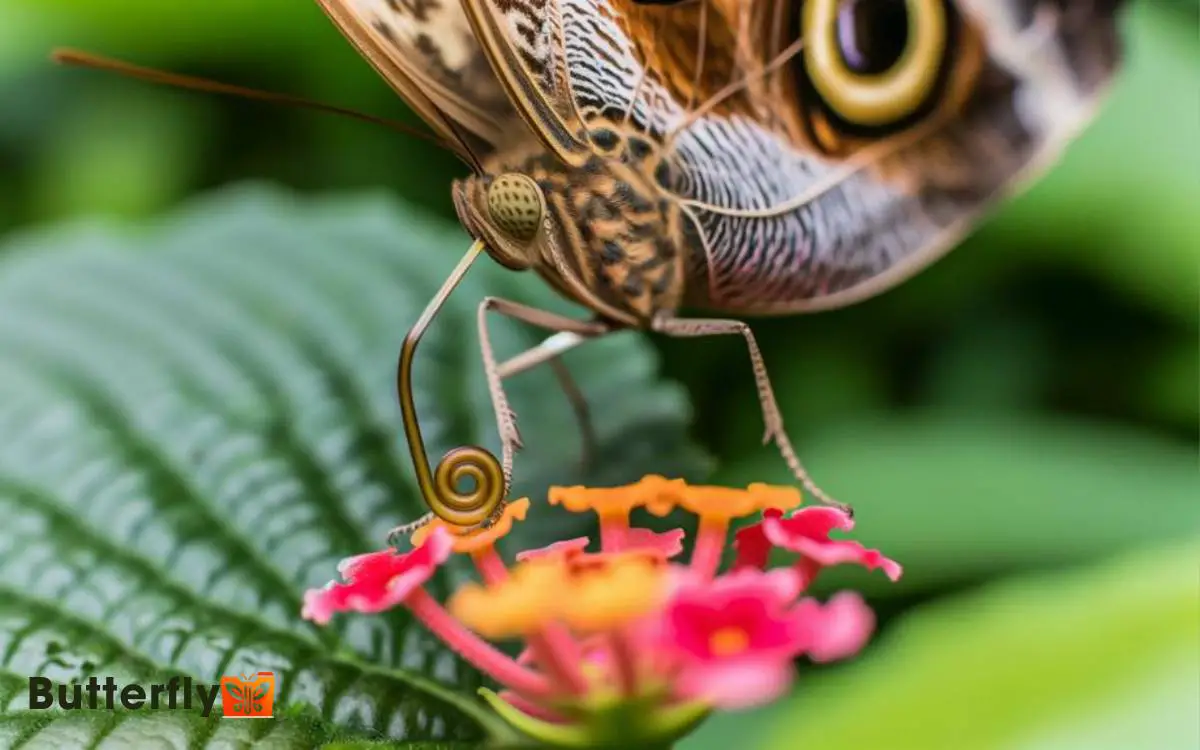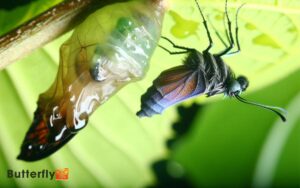Do Butterflies Have a Tongue? Delve into the Details!
Butterflies don’t have tongues like humans do; instead, they use a proboscis, a specialized elongated mouthpart.
The proboscis consists of two interlocked tubes called galeae. It stays coiled under the head when not in use and uncoils to access nectar deep within flowers.
Muscles and hydraulic pressure control its movement for efficient sucking. The proboscis also contains sensory receptors that help butterflies taste and precisely extract the chemical composition of liquids.
These unique adaptations allow butterflies to thrive by effectively feeding and pollinating flowers. To discover more about their fascinating feeding mechanics, continue exploring the topic.

Key Takeaways
Anatomy of the Proboscis
The proboscis of a butterfly, a specialized elongated mouthpart, functions as a highly efficient feeding tube. You’ll find it coiled under the head when not in use.
During feeding, the butterfly uncoils the proboscis, extending it to reach nectar deep within flowers. The structure consists of two interlocked tubes called galeae, which form a single, flexible channel.
Muscles within the proboscis facilitate the sucking motion, drawing nectar into the butterfly’s digestive system.
This design allows butterflies to feed efficiently without damaging delicate flower structures. The proboscis can vary in length, adapting to different flower types.
Evolutionary Adaptations
Understanding the intricate anatomy of the proboscis leads to insights into the evolutionary adaptations that have enabled butterflies to thrive in diverse environments.
You’ll find that the proboscis, a highly specialized feeding organ, has evolved to maximize resource utilization. Its coiled structure allows butterflies to access nectar deep within flowers, giving them a competitive edge.
Over time, selective pressures have shaped the proboscis to vary in length and flexibility, matching the floral diversity of their habitats. This adaptation not only aids in feeding but also facilitates pollination, contributing to ecological balance.
How Butterflies Feed
You’ll find that butterflies use a specialized mouthpart called a proboscis to feed. This long, coiled tube allows them to extract nectar from flowers with remarkable precision.
As they extend the proboscis, they can reach deep within the flower to access the sugary liquid essential for their energy needs.
Proboscis Functionality
Butterflies feed using a specialized, tubular mouthpart called a proboscis that functions much like a drinking straw. This intricate structure helps them reach and consume liquid nutrients. When not in use, the proboscis is coiled tightly under the head.
Upon detecting a food source, the butterfly extends its proboscis to access:
- Nectar from flowers
- Moisture from damp soil
- Tree sap
- Rotting fruit
The proboscis is composed of two interlocking halves that form a tube, allowing the butterfly to siphon liquids efficiently. It’s a marvel of evolutionary adaptation, enabling precise feeding from various surfaces.
Understanding the proboscis’s functionality offers insight into how butterflies have adapted to their environments and dietary needs, making them efficient and effective feeders.
Nectar Extraction Process
To feed on nectar, the butterfly unfurls its proboscis and inserts it into the flower’s nectary, efficiently drawing out the liquid using capillary action. This specialized feeding tube, which is coiled when not in use, extends deeply into the flower to access the sweet nectar.
The butterfly’s proboscis functions like a straw, with tiny grooves that facilitate the upward movement of nectar. As you observe this process, note how the butterfly’s muscular contractions help pump the liquid through the proboscis.
This method guarantees that the butterfly can feed quickly and effectively, maximizing nectar intake while minimizing energy expenditure.
The precise coordination between the proboscis and the flower’s structure highlights the intricate relationship between butterflies and their floral food sources.
Nectar Extraction Process
You’ll find that butterflies use a specialized feeding structure called a proboscis to extract nectar.
This coiled tube unfurls and penetrates deep into flowers, enabling the butterfly to reach the nectar.
The proboscis, equipped with sensory receptors, precisely guides the feeding process, ensuring efficient nectar uptake.
Proboscis Structure
The proboscis, a highly specialized and elongated mouthpart, enables butterflies to efficiently extract nectar from flowers. You’ll find that this structure is both intricate and fascinating.
When a butterfly isn’t feeding, the proboscis remains coiled under its head. Upon locating a flower, the proboscis extends to reach deep into the flower’s nectar reserves.
- Flexible yet durable: The proboscis can bend without breaking, making it ideal for maneuvering into tight floral spaces.
- Hollow tube: It functions like a straw, allowing the butterfly to suck up nectar efficiently.
- Two-part structure: The proboscis consists of two interlocking halves that form a seamless tube.
- Sensory hairs: These detect the presence and quality of nectar, ensuring the butterfly targets the richest sources.
Understanding this structure is key to appreciating how butterflies feed.
Feeding Mechanism
With its proboscis extended, a butterfly employs a precise mechanism to extract nectar from flowers, ensuring it consumes the maximum amount of this essential energy source. You’ll notice how the butterfly unfurls its coiled proboscis and inserts it into the flower’s nectar tube.
The proboscis acts like a straw, using capillary action to draw up the liquid nectar. Muscular contractions in the proboscis help pump the nectar into the butterfly’s digestive system. This process is both efficient and fascinating.
| Step | Description | Function |
|---|---|---|
| 1. Extension | Proboscis unfurls | Access nectar in deep flowers |
| 2. Insertion | Proboscis enters the nectar tube | Reach nectar source |
| 3. Suction | Capillary action draws nectar up | Intake liquid |
| 4. Pumping | Muscular contractions move nectar | Transport nectar to digestion |
| 5. Coiling | Proboscis coils back | Prepares for next feeding session |
This intricate feeding mechanism allows butterflies to thrive on nectar, maximizing their energy intake efficiently.
Comparison to Tongues
Unlike human tongues, a butterfly’s proboscis serves a dual purpose of feeding and tasting through a highly specialized structure.
Human tongues are muscular organs primarily used for tasting and manipulating food. In contrast, a butterfly’s proboscis is a long, coiled tube that functions differently.
You’ll find that it:
- Extracts nectar from flowers with precision.
- Uncoils to reach deep into floral structures.
- Senses the chemical composition of liquids.
- Retracts into a coil when not in use.
This comparison highlights the proboscis’s multifunctionality and complex design, unlike the relatively simpler human tongue.
The proboscis allows butterflies to access food sources that require more sophisticated feeding mechanisms, showcasing an impressive evolutionary adaptation.
Understanding these differences clarifies how each organ is uniquely suited to its organism’s needs.
Proboscis Structure
Delving into its anatomy, you’ll find that a butterfly’s proboscis is a marvel of evolutionary engineering, comprised of two interlocking tubes called galeae. These galeae are intricately joined by a series of hooks and grooves, creating a seamless, flexible straw.
The inner walls of the galeae are lined with thousands of tiny, hair-like structures known as sensilla. These sensilla help the butterfly taste and sense the chemical composition of the nectar it consumes.
The proboscis itself can vary in length across species, adapting to different types of flowers and feeding needs. When extended, it forms a single, continuous tube that allows efficient nectar extraction. This ingenious structure is both durable and highly specialized for feeding.
Coiling Mechanism
You need to understand how the coiling mechanism of a butterfly’s proboscis works.
This flexible structure allows butterflies to efficiently feed on nectar by extending and retracting it.
Observing this process will provide you with insights into their feeding behavior and anatomical adaptations.
Proboscis Structure Overview
Butterflies possess a specialized feeding structure known as the proboscis, which coils and uncoils through a sophisticated mechanism to access nectar from flowers.
You’ll find that this proboscis is an elongated tube made up of two interlocking halves. When not in use, it coils up neatly under the butterfly’s head, resembling a tightly wound spring.
The coiling mechanism involves:
- Hydraulic pressure: Fluid dynamics control the extension and retraction.
- Muscular action: Tiny muscles help manage the curling and uncurling.
- Structural elasticity: The proboscis material allows for flexibility and durability.
- Sensory input: Sensory receptors guide precision in feeding.
Understanding these components gives you insight into the intricate design and functionality of the butterfly’s proboscis, showcasing nature’s engineering marvels.
Feeding Process Explained
Building upon the structural intricacies of the proboscis, let’s examine the coiling mechanism during the butterfly’s feeding process.
When not in use, a butterfly’s proboscis remains tightly coiled beneath its head. This coiling is achieved through intrinsic muscles and cuticular elasticity, allowing the proboscis to unwind smoothly when the butterfly locates nectar.
To feed, the butterfly extends its proboscis by contracting specific muscles that force hemolymph into the proboscis, causing it to straighten. Once extended, the proboscis functions as a straw, drawing nectar up through capillary action and muscular pumps.
After feeding, the proboscis recoils automatically, thanks to the inherent flexibility of its cuticle and the action of retractor muscles. This efficient coiling mechanism guarantees the proboscis is protected when not in use.
Sensory Functions
A butterfly’s sensory functions are essential for locating nectar, avoiding predators, and finding mates. You’ll find their sensory organs are highly specialized and precisely tuned to their needs.
Butterflies use:
- Antennae: These detect chemical signals, helping butterflies find food and mates.
- Eyes: Compound eyes provide a wide field of vision, essential for spotting predators and moving through their environment.
- Feet: Taste receptors located on their feet allow butterflies to sense if a plant is suitable for laying eggs or feeding.
- Proboscis: While primarily used for feeding, it also plays a role in tasting.
Understanding these sensory functions reveals how butterflies interact with their surroundings, ensuring their survival and reproduction. Their sensory adaptations make them highly efficient in their ecological niche. By detecting subtle chemical cues, they can identify suitable host plants for laying eggs and locate nectar sources for sustenance. Interestingly, butterflies taste using chemoreceptors located on their feet, allowing them to assess the quality of a plant simply by landing on it. This unique ability helps them make quick decisions about feeding and reproduction, enhancing their chances of survival in diverse environments.
Proboscis Maintenance
Maintaining the proboscis involves intricate behaviors and physiological processes to guarantee it remains essential and effective for feeding.
You’ll observe butterflies engaging in self-cleaning activities, often using their forelegs to brush and check the proboscis for any debris. This cleaning is vital to ensure the delicate structure remains unblocked and operational.
Additionally, butterflies perform a coiling and uncoiling action that helps in maintaining flexibility and proper alignment of the proboscis. This repetitive motion aids in lubricating the proboscis with saliva, which prevents it from drying out and becoming brittle.
Feeding Behavior
As butterflies keep their proboscis in peak condition, they exhibit fascinating feeding behavior that maximizes their ability to extract nectar efficiently from a wide variety of flowers.
You’ll observe them unfurling their proboscis to probe deep into flowers, displaying remarkable precision. This specialized feeding mechanism allows them to access nectar that other insects might miss.
Key behaviors include:
- Proboscis Extension: Butterflies extend their proboscis to reach nectar located deep within flowers.
- Coiling and Uncoiling: They skillfully coil and uncoil their proboscis as needed.
- Sucking Action: Using a sucking motion, they draw nectar up through the proboscis.
- Selective Feeding: Butterflies choose flowers based on nectar availability and ease of access.
This detailed feeding behavior ensures they effectively nourish themselves while maintaining their energy levels.
Role in Pollination
Butterflies play an important role in pollination by transferring pollen between flowers as they feed on nectar, facilitating plant reproduction.
When a butterfly lands on a flower, its proboscis unfurls to access nectar. During this process, pollen grains stick to the butterfly’s body, particularly its legs and proboscis.
As the butterfly visits the next flower, some of the pollen is transferred, allowing fertilization to occur. This cross-pollination is essential for the biodiversity of plant species and the production of fruits and seeds.
You can observe that butterflies often prefer bright, fragrant flowers, which have evolved to attract them. Their role in pollination supports entire ecosystems by maintaining the genetic diversity and health of flowering plants.
Unique Species Variations
While butterflies contribute significantly to pollination, it’s intriguing to explore the unique adaptations and variations among different species that enhance their ecological roles. These variations not only influence how they feed but also how they interact with their environment.
- Proboscis Length: Species like the hawk moth have exceptionally long proboscises, allowing them to access nectar deep within tubular flowers.
- Feeding Preferences: Some butterflies, such as the Monarch, prefer specific plants like milkweed, which is vital for their lifecycle.
- Wing Patterns: Brightly colored wings in species like the Painted Lady serve as a warning to predators about their toxicity.
- Antennae Sensitivity: Enhanced antennae in some species help in detecting pheromones and locating mates from great distances.
These adaptations illustrate the incredible diversity within the butterfly world.
Conclusion
So, you’ve explored the fascinating world of butterflies and their unique feeding mechanisms. Unlike a tongue, the proboscis is a marvel of evolutionary engineering, allowing efficient nectar extraction and essential pollination.
Just like a high-tech gadget from the future, this specialized structure requires careful maintenance to function at its best. By understanding these intricacies, you gain a deeper appreciation for butterflies’ roles in ecosystems.
Keep an eye out for these remarkable creatures, and you’ll see nature’s ingenuity at work.






